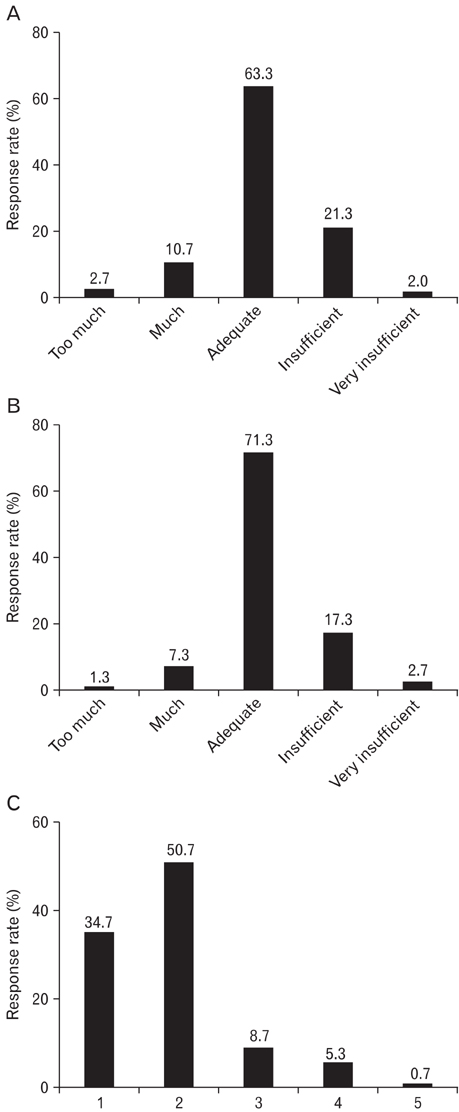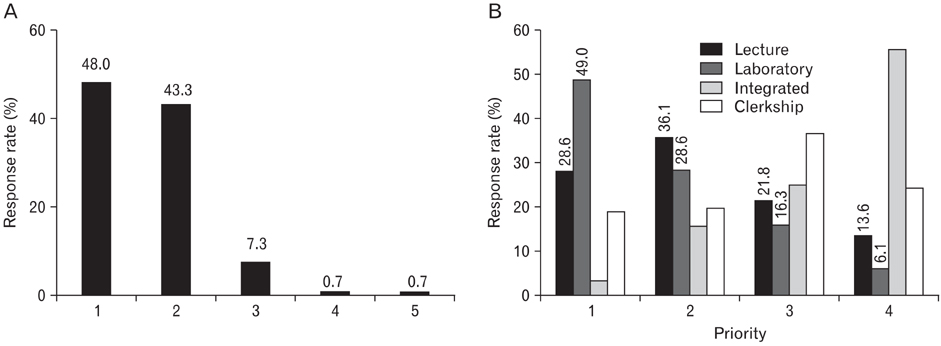Students' perception of anatomy education at a Korean medical college with respect to time and contents
- Affiliations
-
- 1Department of Anatomy, Seoul National University College of Medicine, Seoul, Korea. hyi830@snu.ac.kr
- KMID: 2263108
- DOI: http://doi.org/10.5115/acb.2013.46.2.157
Abstract
- Among medical education institutions worldwide, the time allotted for anatomy instruction has decreased without any reasonable time optimization suggestions. In addition, the utility of cadaver dissection has long been debated. Herein, we surveyed students' perceptions of anatomy education with respect to time and hands-on cadaver dissection, at Seoul National University College of Medicine. With the help of a questionnaire, we surveyed third- and fourth-year students at our institute who had completed the anatomy module as freshmen as well as their clinical clerkship. At our institute, students complete 50 hours of anatomy lectures and 120 hours of dissection laboratory during their first year. According to the survey responses, they generally considered these durations to be adequate for achieving their anatomy education goals. Almost all the students regarded the dissection laboratory as an essential and most helpful modality. Thus, we suggest that these ranges of time along with cadaver dissection could be useful guidelines for optimized anatomy education. The survey data also indicated that a more clinically oriented anatomy education could improve students' results.
Figure
Cited by 4 articles
-
Effects of Reading a Free Electronic Book on Regional Anatomy with Schematics and Mnemonics on Student Learning
Beom Sun Chung, Ki Seok Koh, Chang-Seok Oh, Jin Seo Park, Jae-Ho Lee, Min Suk Chung
J Korean Med Sci. 2020;35(6):. doi: 10.3346/jkms.2020.35.e42.Effects of Reading a Free Electronic Book on Regional Anatomy with Schematics and Mnemonics on Student Learning
Beom Sun Chung, Ki Seok Koh, Chang-Seok Oh, Jin Seo Park, Jae-Ho Lee, Min Suk Chung
J Korean Med Sci. 2020;35(6):. doi: 10.3346/jkms.2020.35.e42.Online educational methods vs. traditional teaching of anatomy during the COVID-19 pandemic
Trifon Totlis, Maksim Tishukov, Maria Piagkou, Michael Kostares, Konstantinos Natsis
Anat Cell Biol. 2021;54(3):332-339. doi: 10.5115/acb.21.006.The creation of a body donation program at Federal University of Juiz de Fora in Brazil: academic importance, challenges and donor profile
André Gustavo Fernandes de Oliveira, Augusto Ferreira Gonçalves, Júlia Nunes Soares, Letícia Henriques Neto Salgado, Bruno Silveira Santana, Matheus Venâncio Passos, Juliana Lopes de Oliveira Reis, Gustavo Candiá Arantes, Luís Filipe Sarmento Campos, Matheus Souza Carvalho, Lucas Cotrim Furtado da Gama, Alice Belleigoli Rezende
Anat Cell Biol. 2021;54(4):489-500. doi: 10.5115/acb.21.096.
Reference
-
1. Cottam WW. Adequacy of medical school gross anatomy education as perceived by certain postgraduate residency programs and anatomy course directors. Clin Anat. 1999. 12:55–65.2. Older J. Anatomy: a must for teaching the next generation. Surgeon. 2004. 2:79–90.3. Turney BW. Anatomy in a modern medical curriculum. Ann R Coll Surg Engl. 2007. 89:104–107.4. Raftery AT. Basic surgical training. 1: Postgraduate surgical examinations in the UK and Ireland. Clin Anat. 1996. 9:163–166.5. Gartner LP. Anatomical sciences in the allopathic medical school curriculum in the United States between 1967-2001. Clin Anat. 2003. 16:434–439.6. Drake RL, McBride JM, Lachman N, Pawlina W. Medical education in the anatomical sciences: the winds of change continue to blow. Anat Sci Educ. 2009. 2:253–259.7. Craig S, Tait N, Boers D, McAndrew D. Review of anatomy education in Australian and New Zealand medical schools. ANZ J Surg. 2010. 80:212–216.8. General Medical Council. Tomorrow's Doctors. Recommendations on undergraduate medical education 1993 [Internet]. 1993. cited 2013 Jun 1. General Medical Council;Available from: http://www.gmc-uk.org/education/undergraduate/historic_policy.asp.9. General Medical Council. Tomorrow's Doctors. Regulating doctors, ensuring good medical practice 2003 [Internet]. 1993. cited 2013 Jun 1. General Medical Council;Available from: http://www.gmc-uk.org/education/undergraduate/historic_policy.asp.10. Granger NA. Dissection laboratory is vital to medical gross anatomy education. Anat Rec B New Anat. 2004. 281:6–8.11. Pawlina W, Lachman N. Dissection in learning and teaching gross anatomy: rebuttal to McLachlan. Anat Rec B New Anat. 2004. 281:9–11.12. McLachlan JC, Bligh J, Bradley P, Searle J. Teaching anatomy without cadavers. Med Educ. 2004. 38:418–424.13. Sugand K, Abrahams P, Khurana A. The anatomy of anatomy: a review for its modernization. Anat Sci Educ. 2010. 3:83–93.14. Plaisant O, Cabanis EA, Delmas V. Going back to dissection in a medical curriculum: the paradigm of Necker-Enfants Malades. Surg Radiol Anat. 2004. 26:504–511.15. Fitzgerald JE, White MJ, Tang SW, Maxwell-Armstrong CA, James DK. Are we teaching sufficient anatomy at medical school? The opinions of newly qualified doctors. Clin Anat. 2008. 21:718–724.16. Hwang YI. Analysis of anatomy education in Korean medical schools. Proceedings of the 59th Annual Meeting of Korean Association of Anatomists. 2009 Oct 22-23; Daegu, Korea. Seoul: Korean Association of Anatomists;53.17. Educational Affairs Committee, American Association of Clinical Anatomists. Clinical anatomy and the physical examination part I: thorax, abdomen, perineum, and pelvis. Clin Anat. 2001. 14:332–348.18. American Association of Clinical Anatomists, Educational Affairs Committee. The clinical anatomy of several invasive procedures. Clin Anat. 1999. 12:43–54.19. A clinical anatomy curriculum for the medical student of the 21st century: gross anatomy. Clin Anat. 1996. 9:71–99.20. Godden DR, Baddeley AD. Context-dependent memory in two natural environments: on land and underwater. Br J Psychol. 1975. 66:325–331.21. Koens F, Mann KV, Custers EJ, Ten Cate OT. Analysing the concept of context in medical education. Med Educ. 2005. 39:1243–1249.22. Koens F, Ten Cate OT, Custers EJ. Context-dependent memory in a meaningful environment for medical education: in the classroom and at the bedside. Adv Health Sci Educ Theory Pract. 2003. 8:155–165.23. Regehr G, Norman GR. Issues in cognitive psychology: implications for professional education. Acad Med. 1996. 71:988–1001.24. Zumwalt AC, Lufler RS, Monteiro J, Shaffer K. Building the body: active learning laboratories that emphasize practical aspects of anatomy and integration with radiology. Anat Sci Educ. 2010. 3:134–140.25. Drake RL. A unique, innovative, and clinically oriented approach to anatomy education. Acad Med. 2007. 82:475–478.26. Vasan NS, DeFouw DO, Holland BK. Modified use of team-based learning for effective delivery of medical gross anatomy and embryology. Anat Sci Educ. 2008. 1:3–9.27. Park A, Schwartz RW, Witzke DB, Roth JS, Mastrangelo M, Birch DW, Jennings CD, Lee EY, Hoskins J. A pilot study of new approaches to teaching anatomy and pathology. Surg Endosc. 2001. 15:245–250.28. Wilson DR, Nava PB. Medical student responses to clinical procedure teaching in the anatomy lab. Clin Teach. 2010. 7:14–18.29. Nutt J, Mehdian R, Parkin I, Dent J, Kellett C. Cadaveric surgery: a novel approach to teaching clinical anatomy. Clin Teach. 2012. 9:148–151.30. Kang SH, Shin JS, Hwang YI. The use of specially designed tasks to enhance student interest in the cadaver dissection laboratory. Anat Sci Educ. 2012. 5:76–82.31. Aziz MA, McKenzie JC, Wilson JS, Cowie RJ, Ayeni SA, Dunn BK. The human cadaver in the age of biomedical informatics. Anat Rec. 2002. 269:20–32.32. Topp KS. Prosection vs. dissection, the debate continues: rebuttal to Granger. Anat Rec B New Anat. 2004. 281:12–14.33. Winkelmann A, Hendrix S, Kiessling C. What do students actually do during a dissection course? First steps towards understanding a complex learning experience. Acad Med. 2007. 82:989–995.34. Bockers A, Jerg-Bretzke L, Lamp C, Brinkmann A, Traue HC, Böckers TM. The gross anatomy course: an analysis of its importance. Anat Sci Educ. 2010. 3:3–11.35. Bergman EM, van der Vleuten CP, Scherpbier AJ. Why don't they know enough about anatomy? A narrative review. Med Teach. 2011. 33:403–409.36. Escobar-Poni B, Poni ES. The role of gross anatomy in promoting professionalism: a neglected opportunity! Clin Anat. 2006. 19:461–467.37. Lachman N, Pawlina W. Integrating professionalism in early medical education: the theory and application of reflective practice in the anatomy curriculum. Clin Anat. 2006. 19:456–460.38. Gunderman RB, Wilson PK. Viewpoint: exploring the human interior: the roles of cadaver dissection and radiologic imaging in teaching anatomy. Acad Med. 2005. 80:745–749.
- Full Text Links
- Actions
-
Cited
- CITED
-
- Close
- Share
- Similar articles
-
- Medical students' perception and satisfaction with group discussion and presentation in medical ohilosophy course
- Homepage to distribute the anatomy learning contents including Visible Korean products, comics, and books
- Are There Gaps in the Perception of Medical Students' Professionalism Between Medical Students and Professors?
- Experiences of nursing students with virtual reality-based anatomy education in Korea: a qualitative content analysis
- Are There Gaps between Medical Students and Professors in the Perception of Students' Professionalism Level? - Secondary Publication



